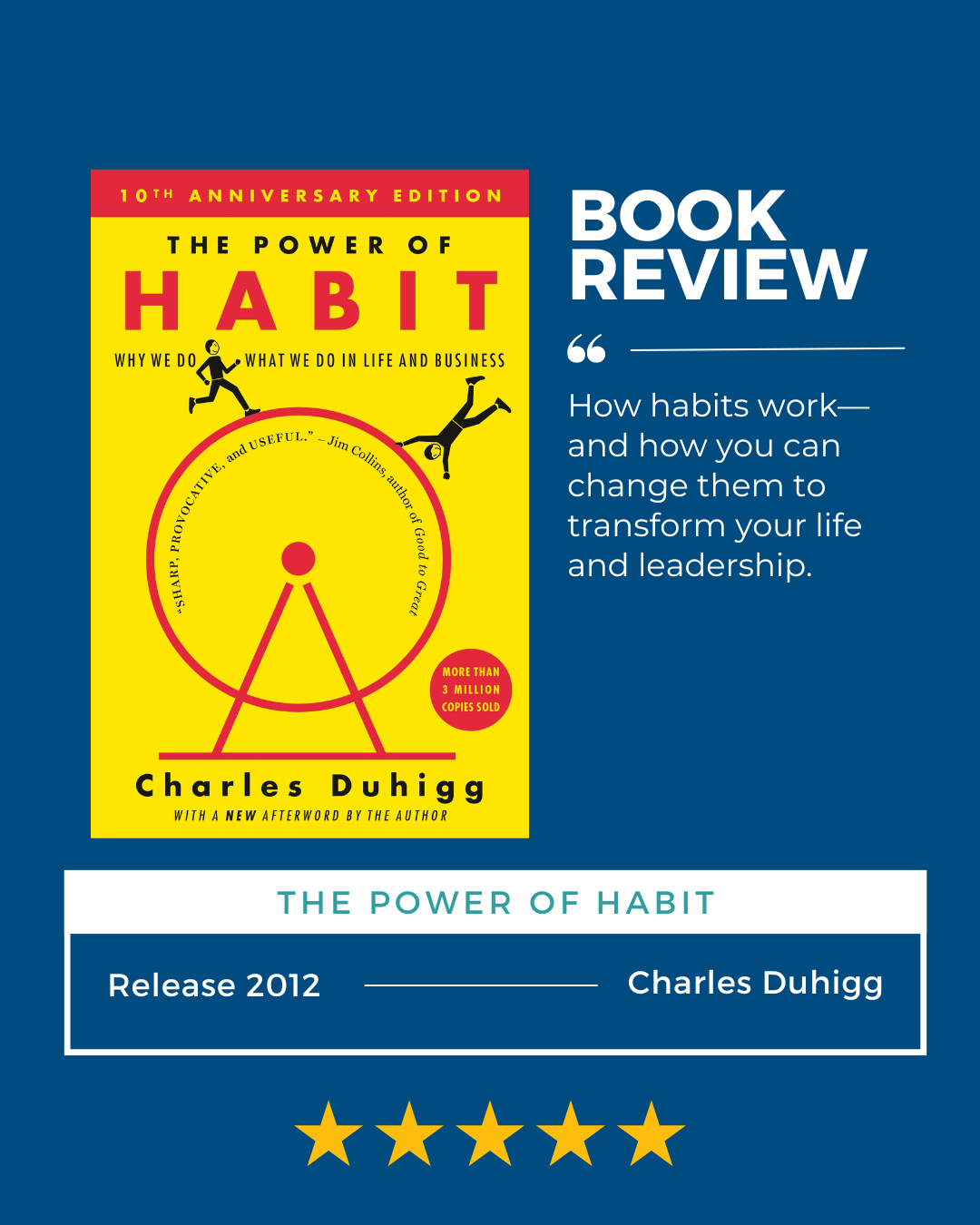Book Review: The Power of Habit by Charles Duhigg
Strong Leadership is built on habits.
From the way you start your morning to how you delegate, respond to conflict, or give feedback, much of what you do happens automatically. That’s the nature of habits. They run in the background, shaping how you lead without much conscious thought.
As a Mindful Leadership Coach, I often help clients break habits that are no longer serving them and create new, sustainable habits that help them have a greater impact on their teams.
In The Power of Habit, Charles Duhigg explores why habits form, how they influence performance, and what it takes to change them. If you liked Atomic Habits by James Clear, this book offers a broader lens. Clear focuses on small, identity-based changes. Duhigg, on the other hand, looks at habits as part of larger systems. His insights are especially useful for leaders who want to influence culture as well as individual behavior.
Here are some key takeaways from Duhigg’s research, along with practical ways to apply them in your leadership. Whether you're leading a team now or preparing to step into that role, these insights will help you lead more intentionally.
1. Understand the Habit Loop: Cue, Routine, Reward
At the heart of Duhigg’s framework is the habit loop, which consists of three parts:
Cue – the trigger that initiates the behavior
Routine – the behavior itself
Reward – the benefit your brain receives that reinforces the habit
Understanding this loop gives you a way to break down habits and intentionally shift them. Once you identify what’s driving the behavior, you can experiment with new routines that still deliver the same reward.
Leadership takeaway:
When a team member misses deadlines or avoids giving feedback, it’s easy to label it as laziness or poor communication. But before making assumptions, consider the habit loop. What might be triggering the behavior? And what reward might they be getting, such as avoiding discomfort or feeling a temporary sense of control? By working together to shift the routine while keeping the reward intact, you can help create more sustainable change instead of relying on short-term fixes.
2. Keystone Habits Create Ripple Effects
Duhigg introduces keystone habits, which are behaviors that spark a chain reaction. When one key habit changes, others often follow. For example, someone who starts exercising regularly may begin sleeping better, eating healthier, and handling stress more calmly.
Leadership takeaway:
Think about the keystone habits that shape your team’s performance. A simple change, like introducing a daily stand-up or blocking off time for deep focus, can ripple out in meaningful ways. Instead of trying to overhaul everything, look for one small shift that has the potential to create broader momentum..
3. Willpower is a Muscle (and a Limited Resource)
Willpower isn’t just a personality trait or something you’re born with. Like a muscle, willpower can be trained and strengthened. Similar to your muscles, willpower can also be depleted without proper rest. Duhigg highlights how stress, fatigue, and decision overload can wear it down, even for high performers.
Leadership takeaway:
Expecting your team to consistently perform well without making space for recovery isn’t realistic. Leaders can support willpower by helping people prioritize, reducing decision fatigue, and normalizing rest. That includes you. When leaders model thoughtful boundaries and sustainable effort, the team takes notice.
4. Change Happens When Belief is Present
Real change takes more than just a new habit. It requires belief that the change is possible, that it matters, and that it’s worth sticking with when things get hard. Duhigg points out that belief is often anchored in community, which is why teams and support systems are so powerful.
Leadership takeaway:
Culture is what reinforces belief. If you want your team to take ownership of change, create an environment where improvement feels real and achievable. Celebrate progress. Encourage honest conversations. Recognize effort, not just outcomes. The more people believe they can grow, and that growth is supported, the more likely habits are to stick.
5. Habits Drive Organizational Culture, Too
While much of The Power of Habit focuses on individuals and personal behavior, Duhigg also explores how habits operate at the organizational level. Stories from companies like Starbucks and Alcoa show how patterns of behavior, once established, define the culture over time.
Leadership takeaway:
If your team or company feels stuck, take a closer look at the habits that are driving the culture. Are people expected to respond to emails instantly? Are meetings unstructured or consistently running long? Do certain voices dominate in feedback conversations? These patterns often become invisible, but with intention, they can be rewritten. Changing culture starts with recognizing which habits are helping and which ones are holding you back.
Final Thoughts
If you’re a leader who values growth, The Power of Habit offers practical insight into how change happens. Duhigg weaves together research, stories, and clear frameworks that help you understand the science behind habits and how to use that knowledge to lead more intentionally.
The bottom line? You don’t have to stay stuck in outdated patterns. When you understand how habits work, you can redesign the way you lead, create space for better decision-making, and shape a culture that supports the kind of work you truly want to do.
Curious how to apply this in your leadership?
Let’s talk about how coaching can help you build new habits that align with your values and support your growth as a mindful leader.






